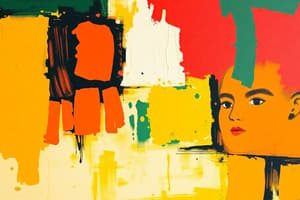Podcast
Questions and Answers
Who is considered the father of Filipino modernism and won the first Gold Medal for his painting 'Spoliarium'?
Who is considered the father of Filipino modernism and won the first Gold Medal for his painting 'Spoliarium'?
- Carlos 'Botong' Francisco
- Juan Luna (correct)
- Jose Rizal
- Felix Resurreccion Hidalgo
Which artist is known for creating grandiose, highly detailed works often depicting biblical narratives and Philippine colonial history?
Which artist is known for creating grandiose, highly detailed works often depicting biblical narratives and Philippine colonial history?
- Carlos 'Botong' Francisco
- Felix Resurreccion Hidalgo (correct)
- Juan Luna
- Francisco Balagtas
Who is the muralist and painter famous for 'Philippine Progress' at the Philippine Central Bank?
Who is the muralist and painter famous for 'Philippine Progress' at the Philippine Central Bank?
- Juan Luna
- Felix Resurreccion Hidalgo
- Paciano Rizal
- Carlos 'Botong' Francisco (correct)
In which town are the Angono Petroglyphs, a collection of prehistoric rock carvings, located?
In which town are the Angono Petroglyphs, a collection of prehistoric rock carvings, located?
Which landmark features contemporary Philippine art and sculptures amidst lush gardens and architectural wonders?
Which landmark features contemporary Philippine art and sculptures amidst lush gardens and architectural wonders?
What do the preserved historical homes in Angono offer a glimpse into?
What do the preserved historical homes in Angono offer a glimpse into?
What is Angono known as?
What is Angono known as?
Which indigenous group dominated the region around Angono before the Spanish invasion?
Which indigenous group dominated the region around Angono before the Spanish invasion?
What is the Baybayin script?
What is the Baybayin script?
During the Spanish period, what artistic style emerged in response to Christian influences?
During the Spanish period, what artistic style emerged in response to Christian influences?
What kind of artwork is associated with Santos?
What kind of artwork is associated with Santos?
What are Petroglyphs?
What are Petroglyphs?
Flashcards are hidden until you start studying
Study Notes
Exploring Ancient Filipino Art in Angono, Rizal
Nestled in the province of Rizal, just east of Manila, lies the town of Angono. Known as the "Art Capital of the Philippines," Angono is a testament to the rich and diverse artistic heritage of the Filipino people. The town's past is steeped in artistic traditions, dating back centuries to the pre-colonial period.
Indigenous Artforms
Long before the Spanish invasion, the Bikol, Tagalog, and Pampanga tribes that once dominated the region created intricate and visually striking works of art. These indigenous art forms included:
- Petroglyphs: Prehistoric carvings found on rocks and stone surfaces dating back to over 3,000 years ago.
- Burial urns: Ceramic vessels used to store cremated human remains, often adorned with intricate geometric and humanoid designs.
- Baybayin script: A pre-colonial writing system that was used to transcribe the Tagalog language.
The Spanish Period
During the Spanish colonial period, Spanish missionaries introduced Christian iconography, deeply influencing Filipino art. The natives adopted and blended these foreign elements with their existing artistic traditions, creating a unique style known as Santos, which depicts Christian saints and religious imagery. Santos remains a hallmark of modern Filipino art and can be seen in various churches and homes throughout the country.
Angono's Artists
Angono has produced several world-renowned artists, including:
- Juan Luna (1857-1899): A painter considered as the father of Filipino modernism, Luna won the first Gold Medal for his painting "Spoliarium" at the 1884 Exposicion General de Bellas Artes in Madrid, Spain.
- Felix Resurreccion Hidalgo (1853-1913): A painter and sculptor known for his grandiose, highly detailed works that often depicted biblical narratives and Philippine colonial history.
- Carlos "Botong" Francisco (1912-1992): A muralist and painter who documented the Filipino way of life in his works. Francisco is most famously known for the massive mural "Philippine Progress" at the Philippine Central Bank (now Bangko Sentral ng Pilipinas).
Angono's Cultural Landmarks
Angono is home to several significant cultural landmarks that showcase its rich artistic heritage:
- Angono Petroglyphs: A collection of over 1,500 prehistoric rock carvings found in the town's Barangay (village) of Pinagrealan, dating back to around 3,500 BC.
- Pinto Art Museum: A private museum and art gallery that features contemporary Philippine art and sculptures, set amidst lush gardens and architectural wonders.
- Angono National Museum: A museum dedicated to Angono's local heritage, showcasing the town's rich artistic history and the works of its most notable artists.
- Angono's Heritage/Cultural Homes: These preserved historical homes are open to the public and offer a glimpse into the lives and works of Angono's most iconic artists.
Angono, Rizal, is a testament to the resilience of Filipino artistic traditions and the enduring beauty of its indigenous art forms. As you explore the town's rich cultural landmarks and immerse yourself in its artistic heritage, you cannot help but marvel at the depth and breadth of the country's artistic legacy.
Studying That Suits You
Use AI to generate personalized quizzes and flashcards to suit your learning preferences.




